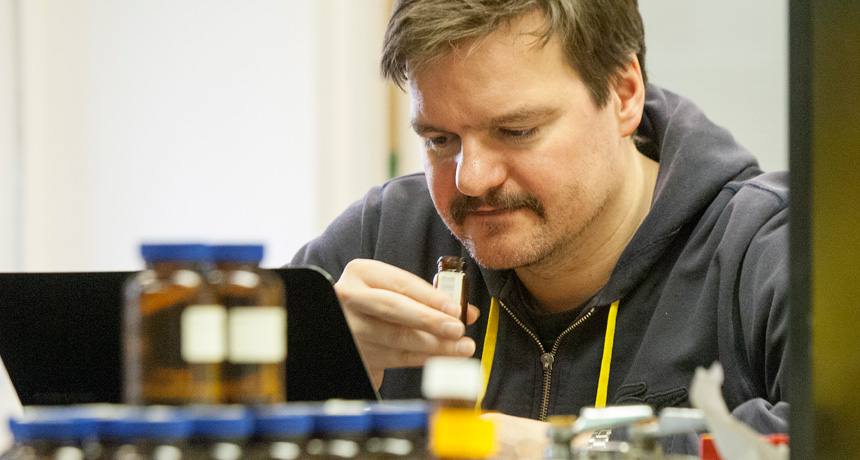
SMELL DETECTORS A researcher whiffs a scent-containing vial used in experiments indicating that people can identify at least 1 trillion different odors.
Zach Veilleux/The Rockefeller Univ.
Respect the nose. Humans use it to tell apart an average of more than 1 trillion odors, a new study finds.
That estimate of smell’s reach vastly exceeds the roughly several million colors and 340,000 tones a typical person can distinguish, reports a team led by geneticist Leslie Vosshall of Rockefeller University in New York City. A decades-old claim that humans discriminate only about 10,000 odors had not been systematically tested until now, the scientists say in the March 21 Science.
Most odor researchers already thought that people could whiff far more than 10,000 scents. Previous investigations found that humans have 400 genes that code for odor-sensing molecules. That’s a sign that smell discrimination played a significant role in human evolution, says Rockefeller geneticist and study coauthor Andreas Keller.
Although sight and hearing outweigh smell as senses necessary for finding food, evading dangers and other daily necessities, the need to discriminate between similar odors is nothing to sniff at, Keller asserts. Consider the advantages of being able to detect the faintest hint of spoiled food, he says.
“We’re visual animals, but this new report highlights humans’ superb sense of smell,” comments neuroscientist Noam Sobel of the Weizmann Institute of Science in Rehovot, Israel. The ability to distinguish among vast numbers of odors proves especially important in social situations, Sobel suspects. His team has shown that women’s emotional tears contain substances that influence men’s behavior via smell (SN: 1/29/11, p. 10).
Vosshall and her colleagues tested the ability of 26 men and women to distinguish scents concocted from 128 odor molecules. Participants were unfamiliar with most of the resulting smells, which were randomly presented in mixtures of 10, 20 or 30 odor molecules.
On each of 264 trials, volunteers sniffed three vials. Two vials contained the same odor; the task was to pick the scent that differed. Paired odor mixtures shared varying numbers of molecules in different trials.
Participants had little difficulty telling the difference between mixtures that shared as much as 51 percent of their odor molecules. The number of volunteers able to tell scents apart declined steadily as pairs of odor mixes shared increasingly more of their components. No one could discriminate between odors that chemically overlapped by more than 90 percent.
Based on individuals’ accuracy rates, the number of possible odor mixtures and the amount of overlap among those mixtures, the researchers calculated that the average participant could discriminate a minimum of more than 1 trillion smells containing 30 odor molecules. The best-performing volunteers could have distinguished many more mixtures than that. Even the least-accurate sniffer could have identified almost 80 million distinct scents, the researchers say.
Humans undoubtedly distinguish way more than 1 trillion smells, Keller says. Many more odor molecules and scent mixtures exist than were tested in the new study.
The new findings suggest that humans can put trillions of odor discriminations to good use, remarks smell scientist Avery Gilbert, president of Synesthetics, Inc., a research consulting firm in Montclair, N.J. “People revel in perfumes and flavors because we can appreciate the nuances that smell provides.” In contrast, nonhuman animals often focus on a relatively narrow range of species-specific scent signals that they discern with exquisite sensitivity, Gilbert says. Limited scent-learning is possible, as in dogs trained to recognize the smell of hidden cocaine or explosives.
It’s still possible that many animals can discriminate a trillion or more odors, Sobel contends. For instance, mice possess about 1,000 genes that code for odor-sensing cells and flies have about 50 such genes. Smell-discrimination studies comparable to the new one have yet to be conducted on nonhuman animals.






